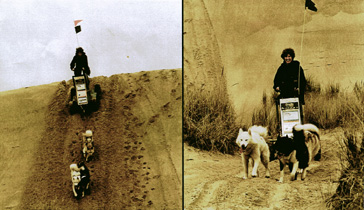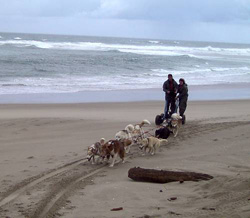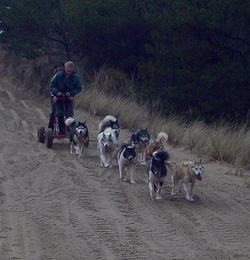Table of Cont
*
Featured Inuit Dog Owner: Ove Nygaard
*
An Amazing Lead Dog: The Story of Tatra
*
A Mystic Reunion
*
Katan, the Greenland Pup
*
Oregon Dune Musher's Mail Run
*
High Arctic Mushing: Part II
*
Bibliography: Inuit Sled Dog Research
*
Video Review: Atanarjuat, The Fast Runner
*
Book Review: To a Lonely Land I Know
*
IMHO: Visibility
Navigating This
Site
Index of articles by subject
Index
of back issues by volume number
Search The
Fan Hitch
Articles
to download and print
Ordering
Ken MacRury's Thesis
Our
comprehensive list of resources
Talk
to The Fan
Hitch
The Fan Hitch
home page
ISDI
home page
Editor: Sue Hamilton
Webmaster: Mark Hamilton
Contents of The Fan Hitch Website and its publications are protected by international copyright laws. No photo, drawing or text may be reproduced in any form without written consent. Webmasters please note: written consent is necessary before linking this site to yours! Please forward requests to Sue Hamilton, 55 Town Line Rd., Harwinton, Connecticut 06791, USA or mail@thefanhitch.org

Sylvia Feder taking the dune plunge .... smiles after her successful descent
Parsons photo
Oregon Dune Musher's Mail Run
by John Senter of Salem, Oregon, USA
As time passes, more events emerge that allow a
recreational or freighting
musher the satisfaction of entering and completing a
serious, challenging
event. One such event, the Oregon Dune Masher's Mail Run,
covers seventy-two
miles over the dunes and is billed as the longest dry-land
dog team event
in the world. For the past twenty-five years, the Mail Run
has been held
in the Oregon Dunes Recreational Area on the central
Oregon Coast. It takes
place on the second weekend of every March.
HISTORY
Jim Tofflemire of North Bend, Oregon founded this event. Jim ran a team of registered Siberian huskies in the 1977 Iditarod. Because he lives very near the dunes, he did the bulk of his Iditarod training there. The topography allowed Jim to do long distance training over a variety of conditions, running on flat beaches, dodging quicksand, crossing bodies of water, and climbing and descending some pretty steep dunes. Training in the dunes also helped Jim train extremely competent lead dogs. There are often no defined trails or roads, so a leader must quickly respond to the masher's commands, even without a landmark.
In 1978, Jim organized and ran the first Mail Run. The
route follows
the old mail stagecoach roads on the dunes. Each team
carries a packet
of commemorative envelopes, signed by the musher, from
start to finish.
These envelopes are sold by the club to raise funds both
to sustain the
Mail Run and to fund Oregon mushers who wish to run the
Iditarod. Jim left
the Mail Run after the 1991 event. Since that time, the
prime mover has
been Bev Meyers. She has been involved in the Mail
Run now for over
twenty years.
CLASSES
The run is comprised of three team classes: Traditional, Advance Party, and the Mini class. The Traditional class consists of those teams with five or more dogs that can do the entire distance at a quick pace. Larger racing teams typically enter in this class. Several Iditarod and Yukon Quest veterans have run the Mail Run Traditional class. This class covers the entire distance of seventy-two miles in two days.
The next class is the Advance Party, consisting of teams of five or more dogs that can do the entire distance but are not as fast as the Traditional teams. Larger recreational teams of Siberians and Malamutes are often found in this class. The Advance Party follows the same route as the Traditional class but leaves the start an hour earlier. This class also covers the entire distance of seventy-two miles in two days.
The Mini class was established in 1987 to allow smaller recreational teams to participate in the event. Teams must have three or four dogs to enter. The Mini class covers a shortened course of fifty-five miles and takes three days to complete.
All teams travel in groups under the guidance of a trail
boss.
EQUIPMENT
Each team must have a four-wheeled cart with effective brakes and steering. Three-wheel carts are not allowed. The club has loaner carts in case a musher wishes to enter but does not have an appropriate cart. The cart must be fitted with a bike antenna on which to fly a safety flag, and must carry certain minimum equipment in a watertight container, usually five-gallon bucket with a tight-fitting lid. The bucket is for repair items, lunch, dog snacks, first aid kit, and, of course, the envelope packet.
Each musher is required to have a handler who not only helps with the team but is responsible for moving the dog truck between towns. Handlers may also be drafted by the Mail Run management for other chores as needed.

Scott & Terry Miller training on the
beach
Gerson photo
ROUTE
The Mail Run begins at the state park on the north side of the mouth of the Coos River and from there heads north. The first leg ends in the resort town of Lakeside. Here, teams are on display for an hour so that mushers and dogs can meet the public.
Teams leave Lakeside and return to the dunes for the second leg. These dunes are much higher and more open than those of the first leg. Here, the teams can experience climbing the high dunes - and going back down them. There may be quicksand out in the flats. This must be avoided. Having a responsive, well-trained lead dog is essential here. This leg of the trip ends in the fishing town of Winchester Bay. Again, the teams are on display for the public. That evening, after the dogs have been fed, bedded down and everyone has had a chance to relax and clean up, mushers, handlers and everyone else associated with the Mail Run meet for pizza and frivolity at a local restaurant.
The third leg for the large teams begins on a logging road north of Winchester Bay. Here the teams access the beach and travel for ten miles to the crossing of a small river. This can be very exciting if the tide is in and the water deep! Here, mushers help each other by guiding lead dogs, tethering teams together, and assuring that all teams in the group have successfully made the crossing. The teams then continue to the Scenic Dunes Overlook and take a rest break there. After this pause, they continue north to Siltcoos State Park for lunch. The Mini teams skip this portion of the run and leave directly from Siltcoos as the large teams are arriving.
This leg ends at Goose Pasture State Park. From there,
the teams are
trucked into Florence, Oregon for a triumphal parade into
Old Town. Teams
are on display for an hour. Afterwards, there is a final
meeting, prizes
are awarded and everyone meets at a local restaurant for
dinner and socializing.
Then home.
TRAINING
This event attracts both serious racers and recreational mushers. A team might be considered recreational, but it must be well-trained and well-conditioned. That means plenty of miles of training. The leaders must be reliable and competent. The best advice I received was to do a minimum of three runs per week, with a minimum distance of five to ten miles per run.
Team dogs must be well socialized to be around other teams and the public in general. Any dog that is shy of strangers, or just a ‘bad actor’ should not be on a Mail Run team. The Mail Run goes through three different towns, and teams are staked out for public viewing in each. Mushers will be asked about their teams and will be asked by spectators if it is okay to pet a dog. Obviously, only trustworthy dogs should be in this position.

Sandy & Jan Hagan training away from
the shoreline.
Gerson
photo
WHAT IT ALL MEANS
The beauty of this event is that it presents an ideal venue for the Inuit Sled Dog. It is not a speed event, but a long distance fun run. More desirable than speed is the ability of a team to maintain a steady pace for long distances, and to be able to pull steep grades. In the Mini teams especially, well-developed freighting dogs have the opportunity to really show what they're made of. A loaded cart is not light and can weigh one hundred-fifty to two hundred pounds without the musher. Here, a freighting team really has a chance to shine.
Preparing for this event compelled me to train harder and more effectively. I had to find places to train other than my usual haunts that would allow me to get the miles on my dogs that I needed for the Mail Run. Before entering the Mail Run, I would train short distances on the weekends and consider myself a musher. After running my first, in 1988 with three Malamutes, I realized just how much I needed to do to be competent in this event. I needed better training areas, more distance and more variety for my dogs and myself. I also needed to visit the dunes occasionally and train there.
The Mail Run takes place near the end of the racing season. It allows racing mushers to run together without actually competing. It also gives the recreational musher the chance to see how well he or she has done training at the end of the season and what needs to be done to further enhance the qualities of the team.
Training in the dunes also makes a team more 'professional' in many ways, especially for a recreational team. I always felt that, irrespective of the training I had done to prepare for the Mail Run, the actual event makes my team more competent. Leaders responded better after than before. The team dogs are better conditioned and steadier. It has been said that one mile on the dunes with a cart is like two miles with a sled in terms of conditioning dogs.
For me, the Mail Run is exactly the sort of challenge that Inuit dogs need. Those of us who don't live in areas where we can expect 'proper' winter weather can certainly benefit from the Oregon Dune Masher's Mail Run or a similar event. Racing teams are spectacular and fast, but I've always felt a quiet satisfaction in seeing a competent, solid team of Inuit Sled Dogs or Malamutes finish the Mail Run, as steadily and purposefully at the end as they were at the start.
For more
information on the Oregon Dune Masher's Mail Run, or to
purchase
commemorative envelopes, please write: Oregon Dune
Mushers, P.O. Box 841,
North Bend, OR 97459-0068, USA, or go to:
<http://www.harborside.com/~mjflcgs/odm/ODMSchedule.htm>